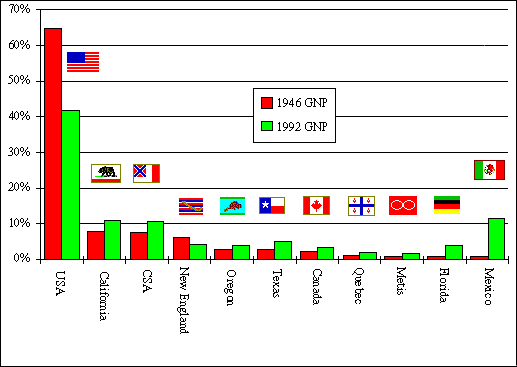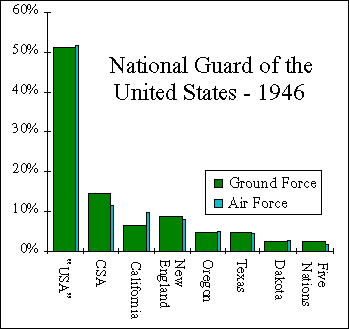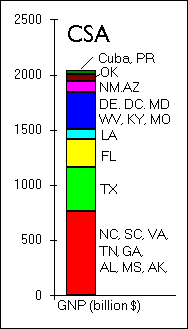
I haven't done any tricky calculations to determine population and gross national product. I merely allocated modern statistics without modification. The purpose here is to give you a better feel for which countries could become world powers and which could not. Although it's very possible that each of these nations would evolve differently under independence, these numbers represent the baseline probablity for a balkanized North America, and if you wanted to make, say, Texas the leading nation on the continent, you'd have to figure out a way to boost the numbers for Texas or lower the numbers for everybody else.
| Rank | Nation | GNP (billion $ purchasing power) |
|---|---|---|
| 1 | USA | 2962 |
| 2 | Japan | 2527 |
| 3 | China | 2234 |
| 4 | Germany | 1345 |
| 5 | India | 1254 |
| 6 | France | 1080 |
| 7 | UK | 1045 |
| 8 | Italy | 999 |
| 9 | Brazil | 886 |
| 10 | Mexico | 829 |
| 11 | California | 764 |
| 12 | CSA | 760 |
| 13 | Russia | 721 |
| 14 | Spain | 515 |
| 15 | Korea (S) | 508 |
| 16 | Texas | 398 |
| 17 | Iran | 310 |
| 18 | Turkey | 305 |
| 19 | New England | 296 |
| 20 | Australia | 284 |
| Sources: |
|---|
| CIA World Factbook |
| US Census Department: Gross State Product |
Population: Generally speaking, North America's short history has left it underpopulated, and no matter how much we fiddle with the numbers, it's unlikely that any alternate history diverging from 1787 could boost the population too much. There just isn't enough time to push the densities up to European or Chinese levels. Even Mexico, which has a relatively high density by American standards, got its start as the core of an old native empire. Nineteenth Century America had a phenomenally high growth rate that probably could not be boosted under any scenario, and it's only been in the past 60 years or so that the American birth rate has dropped off. The best way to increase any of these populations would be to eliminate this drop-off, and the easiest way to do that would be to suppose a more agrarian, less urban, economy for the 20th Century. My guess is that you could use this to increase any population by 25% or so, but a less urban economy might also decrease the GNP.
Immigration to North America has always been pretty high, and it's unlikely that we could push it much higher. If we wanted to reduce some of these populations, we could cut back on immigration, but we can't go too far in this direction either. Empty land attracts settlers, and a growing economy attracts job hunters, so unless we fill the land with native-born farmers or suppose a stagnant economy, we have to accept a steady flow of immigrants.
Having all these borders crisscossing the continent would mean that more Americans would have to stay put. In real history, there was a vast migration of African Americans from the south to the north in the early 20th Century, but it's unlikely that the USA (which didn't even like letting in south Europeans) would have allowed this if there had been a border in the way. When the Gold Rush hit California, American immigrants had the advantage because there were no borders to cross, but in an independent California, Mexicans, Irish, Chinese and Pennsylvanians would all have to pass the same border checkpoints in order to enter the country, so no one nationality would have the advantage. There's no easy answer as to how all these borders would affect overall population growth.
Gross National Product: Since Anglo-America is already one of the richest regions in the world, and its wealth is spread rather uniformly across its geography, my guess is that none of these little countries could be significantly richer than they are today; however, some regions might be poorer without the rest of the continent attached. I won't name names. You know who you are.
The fact is that no one knows for certain why some countries industrialize faster than others, although there does seem to be a strong cultural component to it. The Industrial Revolution began in Great Britain, and then took root in those countries which were close to the British, either geographically (Germany, Belgium) or culturally (North America, Australia). It's certainly not racial or climatic; British colonies in far off places like Hong Kong, Singapore and South Africa have also become rather industrialized. Then for some unknown reason out of the blue, Japan industrialized, and since then, we've seen many former colonies of the Japanese (Korea, Taiwan) develop advanced economies as well.
I only bring this up because you might be tempted to say that because Texas has oil and Ohio does not, Texas would be more prosperous than Ohio. The problem is that resources don't seem to matter. Germany and Japan do all right without oilwells, while oil production doesn't seem to help Nigeria, Azerbaijan and Lybia develop a high standard of living.
Even after we've stripped the United States of most of its territorial expansion, most of its coastline, and 8 of its 13 original states, we are still left with a core nation stretching from New York to Nebraska which has never been seriously threatened with disunity. Sure, during the Civil War, the Confederates hoped that pieces of this rump nation would break off and independently sue for piece, but in our timeline, the Copperhead movement never really got off the ground. I could not find any potential nation to split from this region that was even remotely plausible.

I had originally planned to stir up the anthill and stage some kind of Pan-American War in 1914 or 1940, but there's really no point. It would be a walkover -- no contest at all. As recently as 1946, the eighteen states of the "USA" produced two thirds of of the continent's GNP. At the end of Second World War, the National Guards of these 18 states equaled the combined manpower of the other 30 -- and this doesn't even take into account that the taxes from these states supported over 60% of the regular army. Although the dominance of this region has been eroding over the past 50 years, big multinational wars disappeared with the dawning of the atomic age, so it's too late now to have our Pan-American War.

I suppose we could whittle off the edges of this nation -- no Louisiana Purchase states, no former slave states, an independent New York -- but even if we reduce the "USA" down to a six-star flag (IL, IN, MC, OH, PA, WS) it would still be the richest nation on the continent with 30% of the GNP in 1946 and 17% today.
Amazingly, the answer is yes. The scale of the North American economy is so large that even small pieces of it can be important. The CSA as defined here would have the 12th largest economy in the world.

If we take a moment to debalkanize the South, we can push it even higher. Totalling the 11 traditional Confederate States will bring the GNP up to about $1.5 trillion, or 4th in the world. If we tack on a few marginal areas which could have been included in a Greater CSA, we can add another half trillion dollars to the total, although the rank would stay the same.
Of course, these numbers represent the South after a generation of major growth. Today's Confederacy would account for around 22% of the North American economy, but during the Second World War, it would only account for 11%. An independent Confederacy would not have been a major player in the global politics of that era, and its loss would not have seriously weakened the ability of the remaining United States to defeat the Axis. (If the loss of the Civil War were the only fracture in US history, the GNP of the USA would outweigh the CSA's by 3:1 today and 7:1 in 1946.)
© 1997 Matthew White